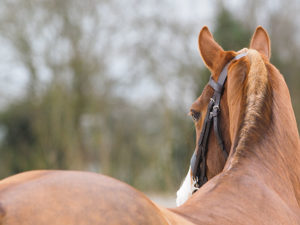Changes in Senior Horses’ Chewing Ability

Horse’s teeth do not grow continually. Rather, they “erupt” and wear over time. By the time a horse reaches his late teens and early 20s, normal age-related changes are occurring within the chewing surfaces of his cheek teeth that cause progressive loss of surface area. Owners need to make dietary changes for their older horses in light of this, and watch for common dental issues seen in this aging population.
The chewing and grinding surfaces of horses’ cheek teeth are rough, due to folds of very hard enamel. They also contain cementum and dentin that surround and fill in the crevices within the enamel folds, respectively. Cementum and dentin are softer than enamel, so they are not useful for grinding feed, especially hay. As a horse ages and wears down his teeth, they get shorter and shorter and their rate of eruption slows.
And as he enters his teens, and certainly by the time he reaches his 20s, the rate of eruption has diminished to the point that new enamel is no longer surfacing to replace the existing enamel. So, these folds begin to wear. The center of each tooth becomes smooth, reducing the horse’s effective chewing surface area. The exposed dentin and cementum continue to wear, eventually causing the tooth to wear down to the gum line. An outer rim of enamel sometimes remains TheHorse.com is home to thousands of free articles about horse health care. In order to access some of our exclusive free content, you must be signed into TheHorse.com. Already have an account?Create a free account with TheHorse.com to view this content.
Start your free account today!
and continue reading.
Related Articles
Stay on top of the most recent Horse Health news with

















